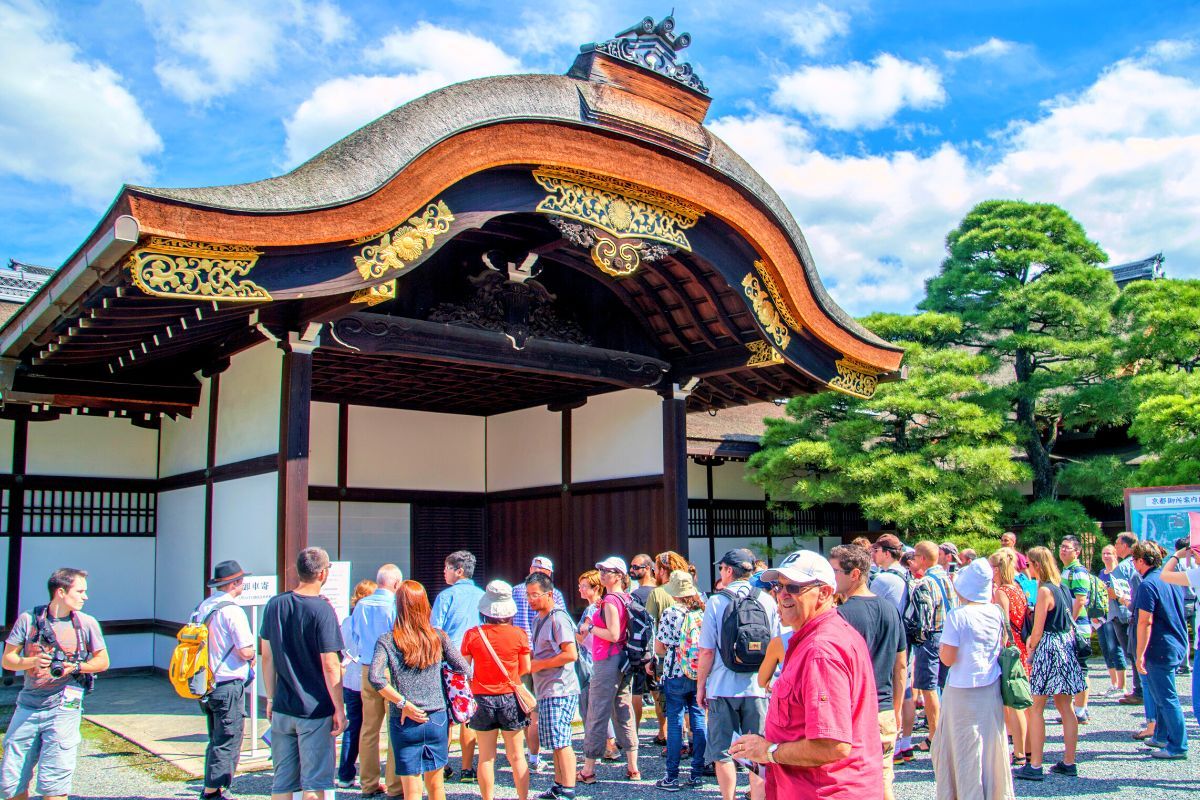Kyoto Imperial Palace: Tickets and Tours
Nestled in the heart of the city, the Kyoto Imperial Palace stands as a symbol of Japan's rich history and architectural grandeur. Once home to the imperial family, this expansive complex offers visitors a rare glimpse into the royal lifestyle and cultural heritage of ancient Japan.
Kyoto Imperial Palace tours are a must-do experience while in Kyoto to see the intricacies of the palace's design, lush gardens and timeless art.
Nestled in the heart of the city, the Kyoto Imperial Palace stands as a symbol of Japan's rich history and architectural grandeur. Once home to the imperial family, this expansive complex offers visitors a rare glimpse into the royal lifestyle and cultural heritage of ancient Japan.
Kyoto Imperial Palace tours are a must-do experience while in Kyoto to see the intricacies of the palace's design, lush gardens and timeless art.

(0/24) checking Musement...
Nestled in the heart of the city, the Kyoto Imperial Palace stands as a symbol of Japan's rich history and architectural grandeur. Once home to the imperial family, this expansive complex offers visitors a rare glimpse into the royal lifestyle and cultural heritage of ancient Japan.
Kyoto Imperial Palace tours are a must-do experience while in Kyoto to see the intricacies of the palace's design, lush gardens and timeless art.

Here's all you need to know about the Kyoto Imperial Palace, one of the most beautiful attractions in Kyoto.
How much do Kyoto Imperial Palace tickets cost?
The Kyoto Imperial Palace tickets have no cost, as the palace is free to visit. However, there is a limited capacity for guided visits, so it's best to book your preferred day and time on the official website before your visit.
Should you book in advance?
Yes, you should book your visit to Kyoto Imperial Palace in advance if you would like to join a guided tour of the palace. Official guided tours are only offered twice a day in English and Chinese and four times per day in Japanese.
If the official guided tours are fully booked for your preferred date, you can book a combo tour with an expert guide to take you to the Kyoto Imperial Palace and other must-see attractions in or around Kyoto.
Are there any combined tours including Kyoto Imperial Palace and other attractions?
Yes, you can combine a tour to the Kyoto Imperial Palace with a visit to the Golden Pavilion or Nijo Castle. This is a great way to save time and money to make sure you don't miss any must-see sites in Kyoto.
Kyoto Imperial Palace and Nijo Castle

This full-day tour in Kyoto kicks off with a visit to Higashi Hongan-ji Temple — the spiritual heart of Japan and the world's largest wooden building.
After that, you'll visit Nishiki Market, known as Kyoto's kitchen, where you can savor the city's specialties, from fresh vegetables to mouthwatering tofu.
Next, explore Nijo Castle, the former residence of the shogun, which is adorned with more than 1,000 stunning sliding door paintings and is the site where the last shogun relinquished his power to the Japanese Emperor.
Lastly, visit the Kyoto Imperial Palace, the former residence of the emperor's family, where you can admire its stunning architecture and beautifully arranged gardens.
The tour begins at Kyoto Station and ends at the same location. Please note that the admission fees for most spots are free, but there is a 600 yen (less than US$5) fee for Nijo Castle.
Kyoto Imperial Palace, Nijo Castle and the Golden Pavilion

Discover the historical legacy of Kyoto on a half-day tour of the city's top castles, temples, palaces, and gardens, perfect for those with limited time. Visit the UNESCO World Heritage Site of Nijo Castle — the former home of the Tokugawa Shogun.
Continue to the popular Kinkakuji Temple, also called the Golden Pavilion, to marvel at its intricate architecture and serene gardens. Explore the Kyoto Imperial Palace, the former residence of the Japanese Emperor, and appreciate the elegance of its interior design and architecture.
What will you see inside?
As you step onto the palace grounds, you'll be transported back in time, witnessing the splendor of Japan's ancient capital. Each building tells a story of royalty, tradition and architectural mastery.
Palace Buildings
During your visit to the Kyoto Imperial Palace, you can marvel at the stunning architecture of the palace buildings, which showcase the refined taste and elegance of Japan's imperial past.
Throne Room
Inside the palace, you will find the majestic throne room, the former site of imperial enthronement ceremonies. This grand space provides a glimpse into the grandeur of Japan's royalty.
Living Quarters
The palace's living quarters, once inhabited by the imperial family, offer a chance to observe the simplicity and elegance of traditional Japanese interior design.
The Gardens
The Kyoto Imperial Palace is surrounded by meticulously arranged gardens, which blend harmoniously with the palace's architecture. These serene and picturesque gardens are a perfect setting for a leisurely stroll.
Residences
While the emperor and the crown prince no longer reside in the palace, their residences still remain on-site. When they visit Kyoto, they stay in these traditional and luxurious accommodations.
Cultural Artifacts
Throughout the palace, you'll encounter a variety of cultural artifacts, such as paintings, sculptures, and traditional pieces, showcasing Japan's rich artistic heritage.
How to get there?
The Kyoto Imperial Palace is in the heart of Kyoto in a vast park called Kyoto Gyoen. You can easily get there from anywhere in Kyoto by foot or public transport.
By bus
You can take bus lines 4, 9, 50 or 101 from Kyoto Station, and get off at the "Kyoto Gyoen" bus stop.
By metro
You can take the Karasuma Metro Line to Marutamachi Station or Imadegawa Station, which are both a 10-15 minute walk from the palace.
By foot
From Nijo Castle, you only need to walk about 15 minutes to reach the Kyoto Imperial Palace, which is mostly a pleasant walk through the Kyoto Gyoen National Garden.
What are the opening times?
The Kyoto Imperial Palace opens at 9 AM year-round, but it closes at different times depending on the season. From April to August, it closes at 5 PM. From October to February, it closes at 4 PM. In September and March, it closes at 4:30 PM.
Please note that the last admission is always 40 minutes before closing time. The Kyoto Imperial Palace is closed on Mondays and national holidays. It is also closed from December 28 to January 4 and on Tuesdays if a national holiday falls on a Monday.
When is the best time to visit the Kyoto Imperial Palace?
It's hard to choose one best time to visit the Kyoto Imperial Palace. The springtime is certainly the most beautiful with the cherry blossoms in full bloom, but this is also peak tourist season, so you can expect bigger crowds and pricier hotel rates.
The same goes for the autumn. The fall foliage is exceptionally picturesque, which both locals and tourists flock to see in droves. If you don't mind the cold, it's worth trying to visit in the winter. You'll have the palace relatively to yourself and, with a dusting of snow, the palace and gardens look like a romantic anime scene.
Which other attractions can be visited in Kyoto?
Travel tips
- Combine Your Visit: The Kyoto Imperial Palace is located within the Kyoto Imperial Park, which is home to several other attractions, such as the Sento Imperial Palace and the Shusuitei Tea House. Consider combining your visit to the palace with these other sites to make the most of your time in the area.
- Respect the Rules: Follow the rules and guidelines set by the Imperial Household Agency, such as not touching the buildings or artifacts and staying on designated pathways.
- Check Opening Times: Before your visit, make sure to check the palace's opening times and any special events or closures to avoid disappointment.
